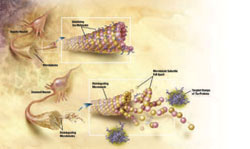
The challenges, compassion, and courage associated with Alzheimer's disease received national exposure earlier this year when Oscar winner Julie Christie starred in a bittersweet Alzheimer's love story, Away From Her, now available on DVD.
Photo: Lions Gate Entertainment
For almost 5 million Americans who suffer from Alzheimer's disease, and the millions more who love and care for them, the world can suddenly seem very frightening. Researchers are making progress, but for now there is no cure for the disease that takes away memory and, ultimately, life itself.
What Is Alzheimer's Disease (AD)?
Dementia (de-MEN-shuh) is a brain disorder that seriously affects a person's ability to carry out daily activities. The most common form of dementia among older people is Alzheimer's disease, which initially involves the parts of the brain that control thought, memory, and language. Although scientists are learning more every day, they still do not know what causes AD, and there is no cure.
As many as five million Americans suffer from AD. The disease usually begins after age 60, and risk goes up with age. Younger people may get the disease, but that is much less common. About five percent of men and women ages 65 to 74 have Alzheimer's, and nearly half of those age 85 and older may have it. But Alzheimer's disease is not a normal part of aging, and it progresses differently from person to person. Although it may last as long as 20 years, most Alzheimer's patients live from 8 to 10 years after diagnosis.
Causes of Alzheimer's Disease
Age is the most important known risk for Alzheimer's. The number of sufferers doubles every five years beyond age 65. Family history is another factor. Genetics may play a role in many cases. Early-onset familial Alzheimer's, a rare form that usually occurs between the ages of 30 and 60, is inherited. The more common form, known as late-onset Alzheimer's, occurs later, and there is no obvious inheritance pattern in most families.
Much remains to learn about what causes AD. In addition to genetics, scientists are studying the influence of education, diet, and environment. There is increasing evidence that some of the risk factors for heart disease and stroke, such as high blood pressure, high cholesterol, and low levels of the vitamin folate, may also increase the risk of AD. Studies also point to physical, mental, and social activities as protective factors.
Diagnosing Alzheimer's
Today, the only definite way to diagnose Alzheimer's is to find out whether there are plaques (clumps of Betaamyloid proteins) and tangles (fibrous "tau" proteins) in brain tissue. But this can be done only by examining the brain after a person dies. Therefore, doctors can only make a diagnosis of "possible" or "probable" Alzheimer's while the person is still alive.
At specialized centers, doctors can diagnose Alzheimer's correctly up to 90 percent of the time. Doctors use several tools to diagnose "probable" AD, including:
- questions about the person's general health, past medical problems, and ability to carry out daily activities;
- tests to measure memory, problem solving, attention, counting, and language;
- medical tests, such as tests of blood, urine, or spinal fluid; and
- brain scans.
No treatment so far stops Alzheimer's. However, for some in the disease's early and middle stages, certain drugs may help prevent some symptoms from becoming worse for a limited time.
Sometimes these tests show that the symptoms are being caused by thyroid problems, drug reactions, depression, brain tumors, or blood vessel disease in the brain, conditions that can cause Alzheimer's-like symptoms but are treatable.
In trying to diagnose Alzheimer's researchers have identified other problems with similarities to AD. One is multi-infarct dementia, which is caused by a series of small strokes or changes in the brain's blood supply that may result in the death of brain tissue. Where they occur determines the seriousness of the problem and the nature of the symptoms. Symptoms that begin suddenly may be a sign of this kind of dementia. Mild cognitive impairment (MCI) is another condition with some similarities to AD. But it differs from both Alzheimer's and normal age-related memory change. People with MCI have ongoing memory problems, but do not experience confusion, attention problems, and difficulty with language.
Treating Alzheimer's
No treatment so far stops Alzheimer's. However, for some in the disease's early and middle stages, certain drugs may help prevent some symptoms from becoming worse for a limited time. Also, some medicines may help control sleeplessness, agitation, wandering, anxiety, and depression. Treating these behavioral symptoms often comforts patients and eases their care.
Five prescription drugs currently are approved by the U.S. Food and Drug Administration to treat people with Alzheimer's disease. Although patients can achieve comfort, dignity, and independence for longer periods, and caregiving can be less difficult, it is important to remember that none of these medications stops the disease itself.
Treatment for Mild to Moderate AD
Four drugs are prescribed for mild to moderate AD. They are Razadyne (galantamine), Exelon (rivastigmine), Aricept (donepezil), and Cognex (tacrine). They are known as cholinesterase inhibitors. Scientists believe they prevent the breakdown of acetylcholine, a brain chemical that may be important for memory, and may help to delay or prevent the symptoms of Alzheimer's from becoming worse for a limited time. As Alzheimer's progresses, the brain produces less and less acetylcholine; therefore, cholinesterase inhibitors may eventually lose their effect.
Treatment for Moderate to Severe AD
The fifth approved drug, known as Namenda (memantine), is prescribed to treat moderate to severe AD. Namenda's main effect is to delay progression of some of the symptoms of moderate to severe Alzheimer's. Patients may be able to maintain certain daily functions a little longer, such as going to the bathroom independently for several more months, benefiting themselves and their caregivers.
Scientists believe that Namenda works by regulating glutamate, another important brain chemical that, when produced in excessive amounts, may lead to brain cell death. Because Namenda works very differently from cholinesterase inhibitors, the two types of drugs can be prescribed in combination.
The FDA also has approved Aricept for the treatment of moderate to severe AD.

"Tangles" of a protein called "tau" occur in Alzheimer's patients' brains-causing neurons to lose their function and increasing memory loss.
Illustration: National Institute on Aging/U.S. National Institutes of Health
NIA Alzheimer's Research
Scientists funded by the National Institute on Aging (NIA) are testing a number of drugs in clinical trials to see if they prevent Alzheimer's, slow the disease, or help reduce its symptoms.
- Mild Cognitive Impairment (MCI) The NIA-funded Memory Impairment Study compared donepezil (Aricept), vitamin E, or a placebo in participants with MCI to see whether the drugs might delay or prevent progression to AD. Compared with those on the placebo, the study group taking donepezil was found to be at reduced risk of progressing to AD for the first 18 months of the three year study. However, the reduced risk disappeared after 18 months, and by the end of the study, the probability of the two groups progressing to AD was the same.
- Neuroimaging Damage to parts of the brain involved in memory, such as the hippocampus, can sometimes be seen on brain scans before symptoms of AD occur. An NIA public-private partnership—the AD Neuroimaging Initiative (ADNI)—is a large study to determine whether magnetic resonance imaging (MRI) and positron emission tomography (PET) scans, or other imaging or biological markers, can see early AD changes or measure its progression.
- AD Genetics The NIA is sponsoring the AD Genetics Study to learn more about risk factor genes for late-onset AD. To participate in this study, families with two or more living siblings diagnosed with AD should contact the National Cell Repository for AD (NCRAD) toll-free at 1-800-526-2839. Information may also be requested through the study's Web site: http://ncrad.iu.edu.
- Inflammation Evidence shows that inflammation in the brain may contribute to AD damage. Some studies have suggested that drugs such as nonsteroidal antiinflammatory drugs (NSAIDs) might help slow AD, but clinical trials thus far have not demonstrated a benefit from these drugs.
- Antioxidants Several years ago, a clinical trial showed that vitamin E slowed the progress of some consequences of AD by about seven months. Additional studies are investigating whether antioxidants—vitamins E and C—can, too.
- Ginkgo biloba Early studies suggested that extracts from the leaves of the ginkgo biloba tree may help treat AD symptoms. There is no evidence yet that ginkgo biloba will cure or prevent AD, but scientists now are trying to find out in a clinical trial whether it can delay cognitive decline or prevent dementia in older people.
To Find Out More
- Estrogen Since some studies have suggested that estrogen used by women to treat the symptoms of menopause also protects the brain, experts also wondered whether estrogen could reduce the risk of or slow AD. However, clinical trials have not shown that it can slow the progression of already diagnosed AD. And one study found that women over the age of 65 who used estrogen with a progestin were at greater risk of dementia, including AD, and that older women using only estrogen could also increase their chance of developing dementia.
